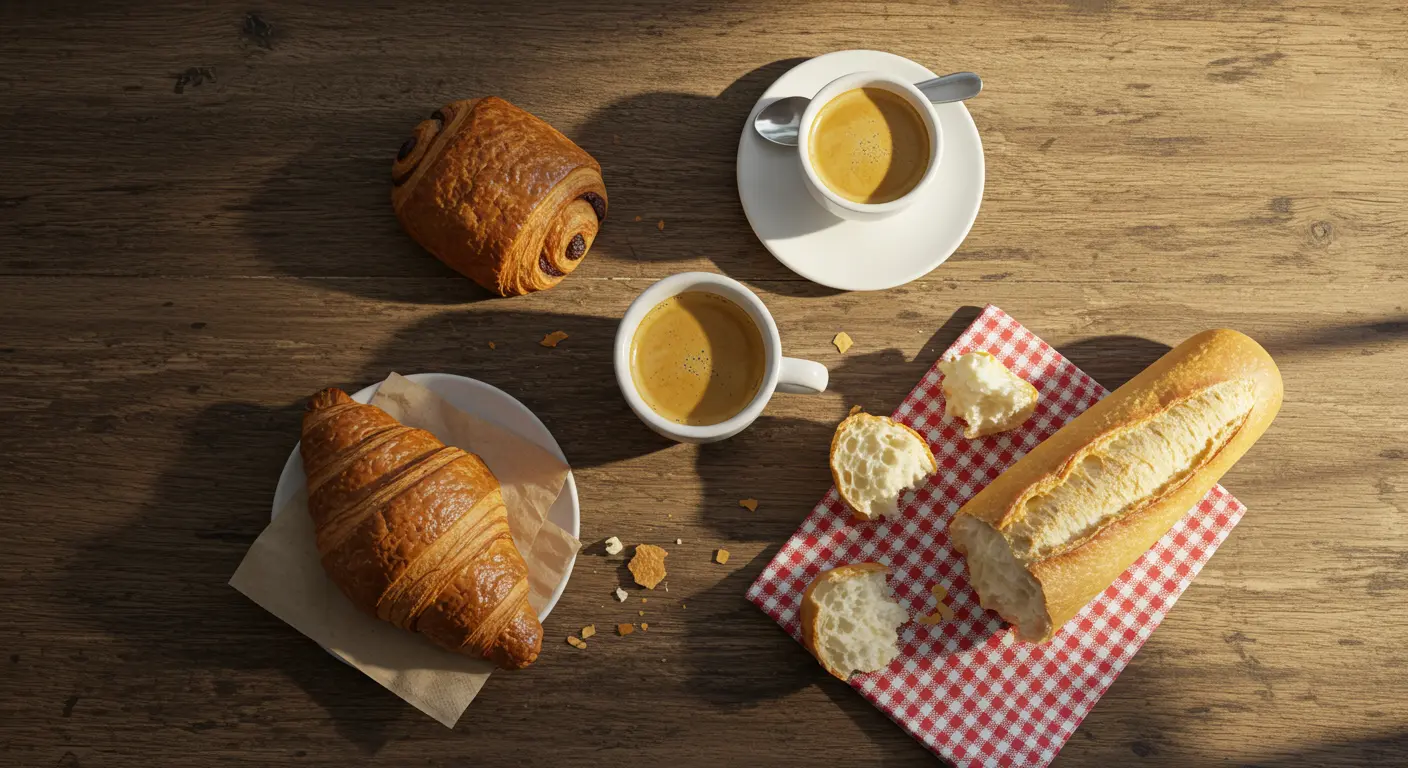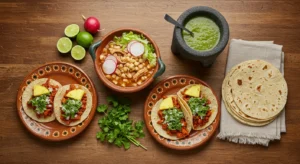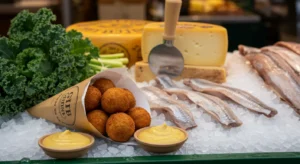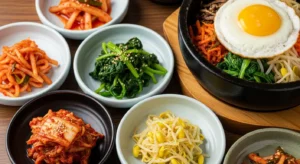Table of Contents
A Beginner’s Guide to the Heart (and Stomach) of France
Let’s be honest. When you think of France food what comes to mind? Probably a crispy baguette under someone’s arm, a fancy plate of escargots, or a tower of colorful macarons. While those icons are real, they’re just the shiny wrapper on a much deeper, richer, and frankly, more delicious story.
The true soul of French cuisine isn’t found in a single dish. It’s found in philosophy. It’s in the morning ritual of choosing the perfect apple tart from the local pâtisserie. It’s in the three-hour lunch where the conversation matters as much as the course. For a beginner, this world can seem intimidating, shrouded in linen tablecloths and complicated menus.
But don’t worry. This guide is your friendly invitation. We’re skipping the clichés and diving into the real, joyful, and utterly captivating world of eating in France. You’ll not only learn what to eat but, more importantly, how to appreciate it like a local.
The French Philosophy: It’s All About Le Terroir
To really “get” French food, you need to know one word: Terroir (teh-rwah).
This concept is the bedrock of everything. It translates loosely to “a sense of place.” It’s the idea that the local environment—the soil, the climate, the topography—imparts a unique character to the food and wine produced there. A goat cheese from the rocky hills of Provence will taste completely different from one made in the Alpine pastures. A wine from Bordeaux is distinct from one from Burgundy because of its terroir.
This is why the French are so fanatical about their local markets and seasonal produce. They don’t just want a tomato; they want a tomato from the sun-drenched fields of Provence, picked at its peak in August. This deep respect for ingredients is the first lesson for any beginner. Food isn’t just fuel; it’s a story of the land.
Beyond the Baguette: Your First-Day-in-France Hit List
Okay, philosophy lesson over. Let’s talk about the good stuff you can actually eat. Here’s a beginner-friendly list to get you started.
The Baker’s Art: Boulangerie & Pâtisserie
First, know the difference. A boulangerie is for bread. A pâtisserie is for pastries and sweets. You’ll often find them combined.
- The Baguette: Yes, you have to try it. But don’t just grab anyone. Look for a sign that says “Boulangerie Artisanale” or “Fait Maison” (meaning homemade). An authentic baguette should have a super-crispy, crackly exterior and a soft, airy, slightly chewy inside with irregular holes. It’s a masterpiece of simplicity.
- The Croissant: The test of a great pâtisserie. It should be incredibly buttery, flaky, and light. A perfect croissant will shatter into a million pieces when you bite into it. The pain au chocolat (chocolate croissant) is its equally delicious cousin.
- The Unassuming Pastry: Skip the eclairs for a moment and ask for a Tarte au Citron (lemon tart) or a Tarte Tatin (an upside-down caramelized apple tart). You’ll taste the difference quality ingredients make.
Café Culture: More Than Just Coffee
Sitting at a French café is a national pastime. The menu can be confusing, so here’s the cheat sheet:
- Un Café: This will get you a shot of espresso. It’s the default.
- Un Café Allongé: An espresso “lengthened” with a bit of hot water. It’s the closest thing to an American coffee.
- Un Crème: An espresso with steamed milk—a café au lait, but typically served in a cup, not a bowl.
- Important Tip: Prices are often lower if you stand at the bar (au comptoir) rather than sitting at a table. Sitting and watching the world go by is worth the extra euro or two, but now you know the secret!
A Tour de France on a Plate: Regional Diversity
France is not a monolith. Its food changes dramatically every time you cross into a new region. This is terroir in action.
- The North (Nord-Pas-de-Calais): Think rich, comforting dishes influenced by neighboring Belgium. This is the home of Carbonnade Flamande, a hearty beef and onion stew slow-cooked with beer.
- The South (Provence, Côte d’Azur): Here, the food is bright, sunny, and herbaceous. It’s all about olive oil, garlic, tomatoes, and herbs de Provence. This is where you’ll find Ratatouille (a vegetable stew) and Bouillabaisse (a complex fish stew from Marseille).
- The East (Alsace): German influence is strong. You’ll find sauerkraut (choucroute), delicious white wines like Riesling, and incredible charcuterie.
- The Southwest (Dordogne, Toulouse): This is duck and goose country. Confit de Canard (duck leg preserved and slow-cooked in its own fat) is a life-changing dish here. It’s also the home of rich, red wine-based stews like Cassoulet.
How to Eat Like a Local: A Beginner’s Rulebook
- Embrace the Market: Find your local marché. Go without a list. Smell, sample, and talk to the vendors. Let what’s freshest and in season dictate your meal. It’s a sensory experience, not a chore.
- Timing is Everything: Restaurants have strict serving hours. Lunch is typically from 12 PM to 2 PM, and dinner starts around 7:30 PM. Don’t expect to find a kitchen open at 4 PM. Plan ahead!
- The Menu Fixe is Your Best Friend: Look for the “Menu” or “Formule” (a set menu). This is almost always a better value than ordering à la carte. It often includes two or three courses (e.g., starter + main, or main + dessert) and is the chef’s way of showcasing what’s best that day.
- Slow Down: A meal is an event. It’s not about rushing. Order a carafe of house wine, enjoy the conversation, and savor every bite. No one will rush you out the door.
Bringing France Home: A Simple Recipe to Start With
You don’t need to be a master chef. The magic is in the technique. Let’s make a classic Omelette Baveuse (“sloppy” or runny omelette). It’s a French breakfast staple and the ultimate test of a cook’s skill, according to many chefs.
- Ingredients: 2-3 fresh eggs, a knob of high-quality butter, salt, and pepper.
- The Method: Whisk the eggs just until combined—streaks of white and yellow are okay. Heat a non-stick pan on medium-high, add the butter until it foams but doesn’t brown. Pour in the eggs. Let them sit for just a few seconds. Now, with a fork, stir vigorously in a circular motion while shaking the pan back and forth. After about 30-45 seconds, the eggs will be mostly set but still wet on top. Tilt the pan and fold one-third of the omelette over itself. Slide it onto a plate, letting it fold again naturally. The inside should be soft, creamy, and slightly runny. Perfection.
Frequently Asked Questions (FAQs)
Q: Is French food always fancy and expensive?
A: Absolutely not! While haute cuisine exists, the heart of French eating is in the humble bistros, bustling markets, and home kitchens. A jambon-beurre (ham and butter on a baguette) is a national treasure and costs just a few euros. Some of the best meals are the simplest.
Q: I’m a picky eater. Will I find anything I like?
A: France has something for everyone. If you’re hesitant, start with the classics you know you’ll like: roasted chicken (poulet rôti), steak with fries (steak frites), or the incredible selection of cheeses and breads. You can always find familiar, delicious options.
Q: What’s the deal with French cheese? It seems overwhelming.
A: It can be! A good rule of thumb is to try a variety: a hard cheese (like Comté), a soft cheese (like Camembert), a blue cheese (like Roquefort), and a goat cheese (Chèvre). Ask your fromager (cheese monger) for a recommendation. They love introducing beginners to new flavors.
Q: Do I need to speak French to enjoy the food?
A: Not at all. Knowing a few key phrases goes a long way. A cheerful “Bonjour!” upon entering any shop and a “Merci, au revoir!” when leaving is essential politeness. For ordering, pointing and a friendly “s’il vous plaît” (please) is perfectly acceptable. Most importantly, smile!
Your Delicious Journey Awaits
French food isn’t about perfection; it’s about passion. It’s about the joy of a perfectly ripe strawberry, the shared laughter over a bottle of wine, and the quiet satisfaction of a well-made omelette. It’s a cuisine that invites you to be present, to taste intentionally, and to celebrate the simple, incredible gift of a good meal.
So, the next time you see a baguette, remember it’s not just bread. It’s a key. A key to understanding a culture that, for centuries, has believed that taking the time to eat well is one of the greatest pleasures in life. Your adventure is just beginning. Bon appétit!
For an authoritative deep dive into the history and cultural significance of French gastronomy, you can explore the resources available at the Michelin Guide, a globally recognized institution in the culinary world.




